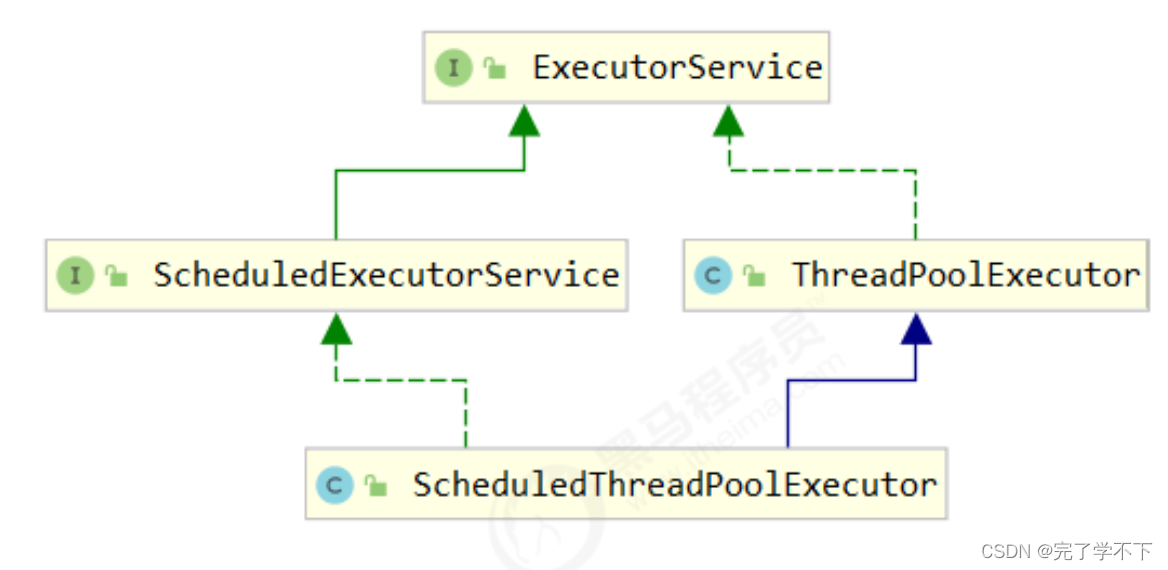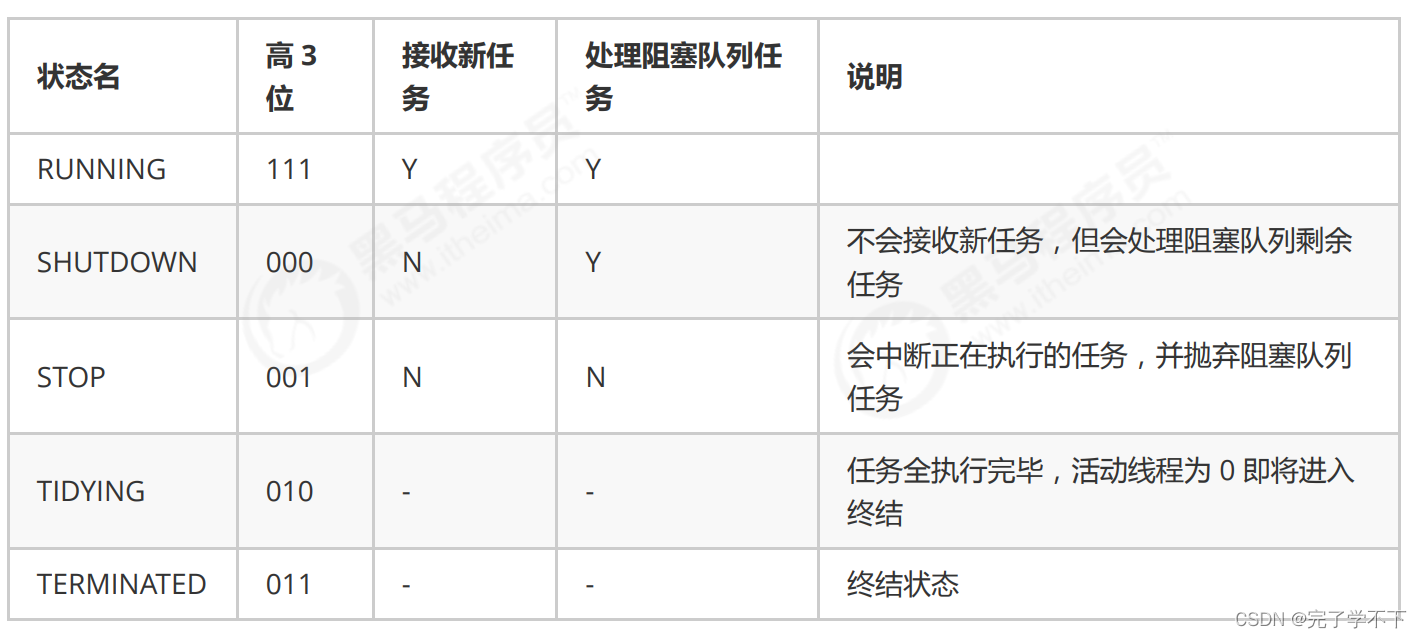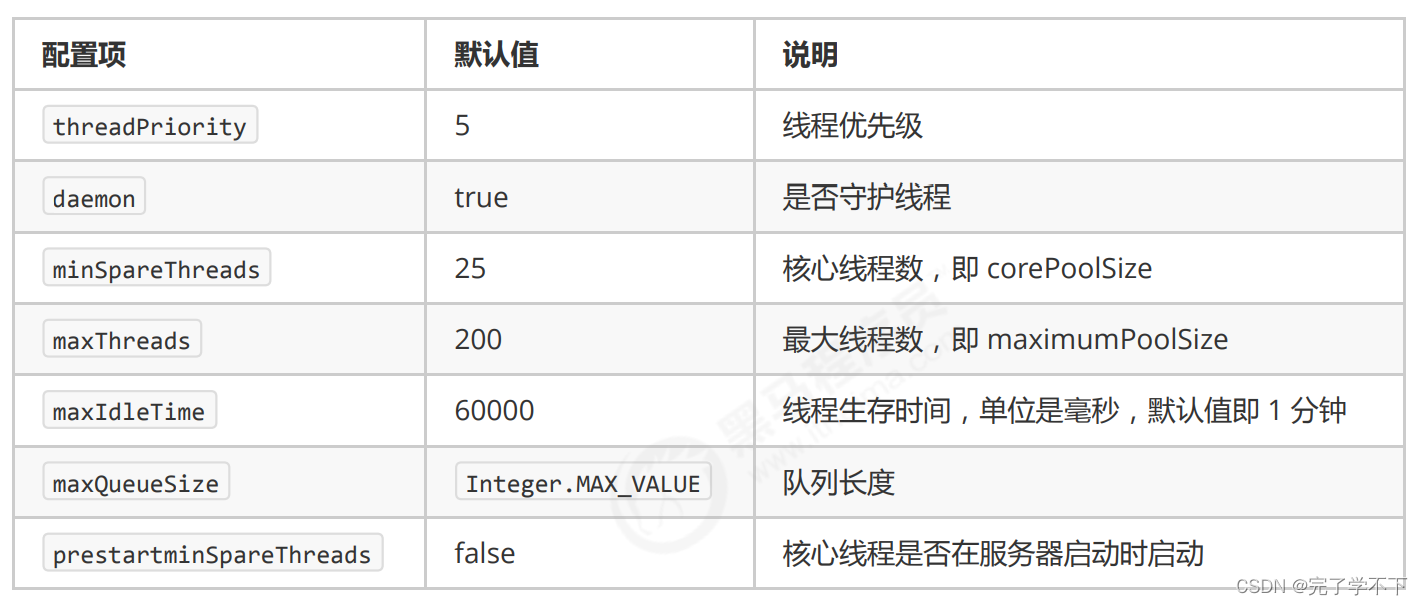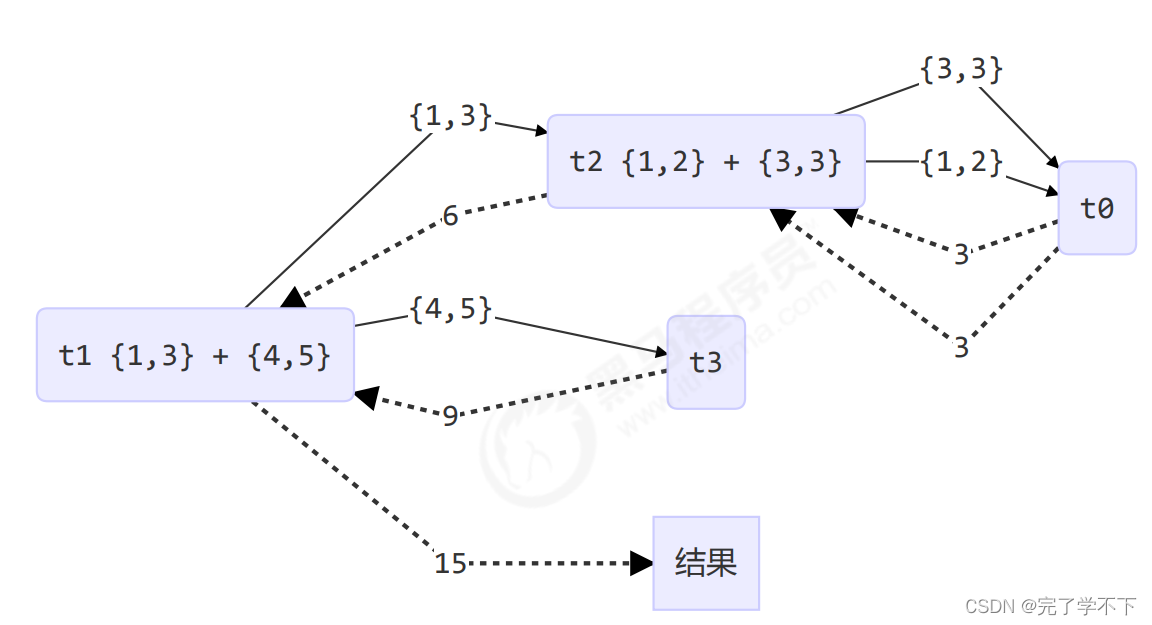目录

0)创建多少线程池合适
- 过小会导致程序不能充分地利用系统资源、容易导致饥饿
- 过大会导致更多的线程上下文切换,占用更多内存
CPU 密集型运算
通常采用 cpu 核数 + 1 能够实现最优的 CPU 利用率,+1 是保证当线程由于页缺失故障(操作系统)或其它原因 导致暂停时,额外的这个线程就能顶上去,保证 CPU 时钟周期不被浪费。
I/O 密集型运算
CPU 不总是处于繁忙状态,例如,当你执行业务计算时,这时候会使用 CPU 资源,但当你执行 I/O 操作时、远程 RPC 调用时,包括进行数据库操作时,这时候 CPU 就闲下来了,你可以利用多线程提高它的利用率。
经验公式如下:
线程数 = 核数 * 期望 CPU 利用率 * 总时间(CPU计算时间+等待时间) / CPU 计算时间
例如 4 核 CPU 计算时间是 50% ,其它等待时间是 50%,期望 cpu 被 100% 利用,套用公式 4 * 100% * 100% / 50% = 8
例如 4 核 CPU 计算时间是 10% ,其它等待时间是 90%,期望 cpu 被 100% 利用,套用公式 4 * 100% * 100% / 10% = 40
1) 线程池状态
ThreadPoolExecutor 使用 int 的高 3 位来表示线程池状态(第一位是符号位),低 29 位表示线程数量。

从数字上比较,TERMINATED > TIDYING > STOP > SHUTDOWN > RUNNING
private final AtomicInteger ctl = new AtomicInteger(ctlOf(RUNNING, 0));
// c 为旧值, ctlOf 返回结果为新值
ctl.compareAndSet(c, ctlOf(targetState, workerCountOf(c))));
// 打包和解包 ctl
private static int runStateOf(int c) { return c & ~CAPACITY; }
private static int workerCountOf(int c) { return c & CAPACITY; }
// rs 为高 3 位代表线程池状态, wc 为低 29 位代表线程个数,ctl 是合并它们
private static int ctlOf(int rs, int wc) { return rs | wc; }
2) 构造方法
public ThreadPoolExecutor(int corePoolSize,
int maximumPoolSize,
long keepAliveTime,
TimeUnit unit,
BlockingQueue<Runnable> workQueue,
ThreadFactory threadFactory,
RejectedExecutionHandler handler){}
corePoolSize 核心线程数目 (最多保留的线程数)
maximumPoolSize 最大线程数目
keepAliveTime 生存时间 - 针对救急线程
unit 时间单位 - 针对救急线程
workQueue 阻塞队列
threadFactory 线程工厂 - 可以为线程创建时起个好名字
handler 拒绝策略工作方式:
- 线程池中刚开始没有线程,当一个任务提交给线程池后,线程池会创建一个新线程来执行任务。
- 当线程数达到 corePoolSize 并没有线程空闲,这时再加入任务,新加的任务会被加入workQueue 队列排队,直到有空闲的线程。
- 如果队列选择了有界队列,那么任务超过了队列大小时,会创建 maximumPoolSize - corePoolSize 数目的线程来救急。
- 如果线程到达 maximumPoolSize 仍然有新任务这时会执行拒绝策略。拒绝策略 jdk 提供了 4 种实现,其它 著名框架也提供了实现
- AbortPolicy 让调用者抛出 RejectedExecutionException 异常,这是默认策略
- CallerRunsPolicy 让调用者运行任务
- DiscardPolicy 放弃本次任务
- DiscardOldestPolicy 放弃队列中最早的任务,本任务取而代之

- Dubbo 的实现,在抛出 RejectedExecutionException 异常之前会记录日志,并 dump 线程栈信息,方便定位问题
- Netty 的实现,是创建一个新线程来执行任务
- ActiveMQ 的实现,带超时等待(60s)尝试放入队列,类似我们之前自定义的拒绝策略
- PinPoint 的实现,它使用了一个拒绝策略链,会逐一尝试策略链中每种拒绝策略
- 当高峰过去后,超过corePoolSize 的救急线程如果一段时间没有任务做,需要结束节省资源,这个时间由 keepAliveTime 和 unit 来控制。
3)工厂方法
1) newFixedThreadPool
public static ExecutorService newFixedThreadPool(int nThreads) {
return new ThreadPoolExecutor(nThreads, nThreads,
0L, TimeUnit.MILLISECONDS,
new LinkedBlockingQueue<Runnable>());
}
特点:
核心线程数 == 最大线程数(没有救急线程被创建),因此也无需超时时间
阻塞队列是无界的,可以放任意数量的任务
评价: 适用于任务量已知,相对耗时的任务
2)newCachedThreadPool
public static ExecutorService newCachedThreadPool() {
return new ThreadPoolExecutor(0, Integer.MAX_VALUE,
60L, TimeUnit.SECONDS,
new SynchronousQueue<Runnable>());
}
特点:
1.核心线程数是 0, 最大线程数是 Integer.MAX_VALUE,救急线程的空闲生存时间是 60s,意味着
- 全部都是救急线程(60s 后可以回收)
- 救急线程可以无限创建
2.队列采用了 SynchronousQueue 实现特点是,它没有容量,没有线程来取是放不进去的(一手交钱、一手交
货)
评价: 整个线程池表现为线程数会根据任务量不断增长,没有上限,当任务执行完毕,空闲 1分钟后释放线
程。 适合任务数比较密集,但每个任务执行时间较短的情况
3)) newSingleThreadExecutor
public static ExecutorService newSingleThreadExecutor() {
return new FinalizableDelegatedExecutorService
(new ThreadPoolExecutor(1, 1,
0L, TimeUnit.MILLISECONDS,
new LinkedBlockingQueue<Runnable>()));
}
使用场景:
希望多个任务排队执行。线程数固定为 1,任务数多于 1 时,会放入无界队列排队。任务执行完毕,这唯一的线程也不会被释放。
区别:
自己创建一个单线程串行执行任务,如果任务执行失败而终止那么没有任何补救措施,而线程池还会新建一
个线程,保证池的正常工作
Executors.newSingleThreadExecutor() 线程个数始终为1,不能修改
FinalizableDelegatedExecutorService 应用的是装饰器模式,只对外暴露了 ExecutorService 接口,因此不能调用 ThreadPoolExecutor 中特有的方法
Executors.newFixedThreadPool(1) 初始时为1,以后还可以修改
对外暴露的是 ThreadPoolExecutor 对象,可以强转后调用 setCorePoolSize 等方法进行修改4)提交任务
// 执行任务
void execute(Runnable command);
// 提交任务 task,用返回值 Future 获得任务执行结果
<T> Future<T> submit(Callable<T> task);
// 提交 tasks 中所有任务
<T> List<Future<T>> invokeAll(Collection<? extends Callable<T>> tasks)
throws InterruptedException;
// 提交 tasks 中所有任务,带超时时间
<T> List<Future<T>> invokeAll(Collection<? extends Callable<T>> tasks,
long timeout, TimeUnit unit)
throws InterruptedException;
// 提交 tasks 中所有任务,哪个任务先成功执行完毕,返回此任务执行结果,其它任务取消
<T> T invokeAny(Collection<? extends Callable<T>> tasks)
throws InterruptedException, ExecutionException;
// 提交 tasks 中所有任务,哪个任务先成功执行完毕,返回此任务执行结果,其它任务取消,带超时时间
<T> T invokeAny(Collection<? extends Callable<T>> tasks,
long timeout, TimeUnit unit)
throws InterruptedException, ExecutionException, TimeoutException;5) 关闭线程池
线程池状态变为 SHUTDOWN
- 不会接收新任务
- 但已提交任务会执行完
- 此方法不会阻塞调用线程的执行
void shutdown();
public void shutdown() {
final ReentrantLock mainLock = this.mainLock;
mainLock.lock();
try {
checkShutdownAccess();
// 修改线程池状态
advanceRunState(SHUTDOWN);
// 仅会打断空闲线程
interruptIdleWorkers();
onShutdown(); // 扩展点 ScheduledThreadPoolExecutor
} finally {
mainLock.unlock();
}
// 尝试终结(没有运行的线程可以立刻终结,如果还有运行的线程也不会等,等运行线程自己结束)
tryTerminate();
}
线程池状态变为 STOP
- 不会接收新任务
- 会将队列中的任务返回
- 并用 interrupt 的方式中断正在执行的任务
List<Runnable> shutdownNow();
public List<Runnable> shutdownNow() {
List<Runnable> tasks;
final ReentrantLock mainLock = this.mainLock;
mainLock.lock();
try {
checkShutdownAccess();
// 修改线程池状态
advanceRunState(STOP);
// 打断所有线程
interruptWorkers();
// 获取队列中剩余任务
tasks = drainQueue();
} finally {
mainLock.unlock();
}
// 尝试终结
tryTerminate();
return tasks;
}
// 不在 RUNNING 状态的线程池,此方法就返回 true
boolean isShutdown();
// 线程池状态是否是 TERMINATED
boolean isTerminated();
// 调用 shutdown 后,由于调用线程并不会等待所有任务运行结束,
// 因此如果它想在线程池 TERMINATED 后做些事情,可以利用此方法等待
boolean awaitTermination(long timeout, TimeUnit unit) throws InterruptedException;6) 任务调度线程池
//创建一个线程池,可以安排命令在给定延迟后运行,或定期执行
形参:
corePoolSize – the number of threads to keep in the pool, even if they are idle
返回值:
a newly created scheduled thread pool
抛出:
IllegalArgumentException – if corePoolSize < 0
public static ScheduledExecutorService newScheduledThreadPool(int corePoolSize) {
return new ScheduledThreadPoolExecutor(corePoolSize);
}
评价
整个线程池表现为:线程数固定,任务数多于线程数时,会放入无界队列排队。任务执行完毕,这些线
程也不会被释放。用来执行延迟或反复执行的任务ScheduledExecutorService executor = Executors.newScheduledThreadPool(2);
//
// 添加两个任务,希望它们都在 1s 后执行,只执行一次
//(周期1s,只要可执行即按周期运行,不受其它任务影响)
executor.schedule(() -> {
System.out.println("任务1,执行时间:" + new Date());
try { Thread.sleep(2000); } catch (InterruptedException e) { }
}, 1000, TimeUnit.MILLISECONDS);
executor.schedule(() -> {
System.out.println("任务2,执行时间:" + new Date());
}, 1000, TimeUnit.MILLISECONDS);
任务1,执行时间:Thu Jan 03 12:45:17 CST 2019
任务2,执行时间:Thu Jan 03 12:45:17 CST 2019
scheduleAtFixedRate 例子(任务执行时间超过了间隔时间):
ScheduledExecutorService pool = Executors.newScheduledThreadPool(1);
log.debug("start...");
pool.scheduleAtFixedRate(() -> {
log.debug("running...");
sleep(2);
}, 1, 1, TimeUnit.SECONDS);
输出分析:一开始,延时 1s,接下来,由于任务执行时间 > 间隔时间,间隔被『撑』到了 2s
21:44:30.311 c.TestTimer [main] - start...
21:44:31.360 c.TestTimer [pool-1-thread-1] - running...
21:44:33.361 c.TestTimer [pool-1-thread-1] - running...
21:44:35.362 c.TestTimer [pool-1-thread-1] - running...
21:44:37.362 c.TestTimer [pool-1-thread-1] - running...
scheduleWithFixedDelay 例子:
ScheduledExecutorService pool = Executors.newScheduledThreadPool(1);
log.debug("start...");
pool.scheduleWithFixedDelay(()-> {
log.debug("running...");
sleep(2);
}, 1, 1, TimeUnit.SECONDS);
输出分析:一开始,延时 1s,scheduleWithFixedDelay 的间隔是 上一个任务结束 <-> 延时 <-> 下一个任务开始 所
以间隔都是 3s
21:40:55.078 c.TestTimer [main] - start...
21:40:56.140 c.TestTimer [pool-1-thread-1] - running...
21:40:59.143 c.TestTimer [pool-1-thread-1] - running...
21:41:02.145 c.TestTimer [pool-1-thread-1] - running...
21:41:05.147 c.TestTimer [pool-1-thread-1] - running...
7) 正确处理执行任务异常
1.try{}catch(){}主动捉异常
2.使用 Future
ExecutorService pool = Executors.newFixedThreadPool(1);
Future<Boolean> f = pool.submit(() -> {
log.debug("task1");
int i = 1 / 0;
return true;
});
log.debug("result:{}", f.get());
//Future返回异常
21:54:58.208 c.TestTimer [pool-1-thread-1] - task1
Exception in thread "main" java.util.concurrent.ExecutionException:
java.lang.ArithmeticException: / by zero
at java.util.concurrent.FutureTask.report(FutureTask.java:122)
at java.util.concurrent.FutureTask.get(FutureTask.java:192)
at cn.itcast.n8.TestTimer.main(TestTimer.java:31)
Caused by: java.lang.ArithmeticException: / by zero
at cn.itcast.n8.TestTimer.lambda$main$0(TestTimer.java:28)
at java.util.concurrent.FutureTask.run(FutureTask.java:266)
at java.util.concurrent.ThreadPoolExecutor.runWorker(ThreadPoolExecutor.java:1149)
at java.util.concurrent.ThreadPoolExecutor$Worker.run(ThreadPoolExecutor.java:624)
at java.lang.Thread.run(Thread.java:748) 8)定时任务
如何让每周四 18:00:00 定时执行任务?
// 获得当前时间
LocalDateTime now = LocalDateTime.now();
// 获取本周四 18:00:00.000
LocalDateTime thursday =
now.with(DayOfWeek.THURSDAY).withHour(18).withMinute(0).withSecond(0).withNano(0);
// 如果当前时间已经超过 本周四 18:00:00.000, 那么找下周四 18:00:00.000
if(now.compareTo(thursday) >= 0) {
thursday = thursday.plusWeeks(1);
}
// 计算时间差,即延时执行时间
long initialDelay = Duration.between(now, thursday).toMillis();
// 计算间隔时间,即 1 周的毫秒值
long oneWeek = 7 * 24 * 3600 * 1000;
ScheduledExecutorService executor = Executors.newScheduledThreadPool(2);
System.out.println("开始时间:" + new Date());
executor.scheduleAtFixedRate(() -> {
System.out.println("执行时间:" + new Date());
}, initialDelay, oneWeek, TimeUnit.MILLISECONDS);
9) Tomcat 线程池

- LimitLatch 用来限流,可以控制最大连接个数,类似 J.U.C 中的 Semaphore
- Acceptor 只负责【接收新的 socket 连接】
- Poller 只负责监听 socket channel 是否有【可读的 I/O 事件】
- 一旦可读,封装一个任务对象(socketProcessor),提交给 Executor 线程池处理
- Executor 线程池中的工作线程最终负责【处理请求】
Tomcat 线程池扩展 ThreadPoolExecutor,行为稍有不同,如果总线程数达到 maximumPoolSize 这时不会立刻抛 RejectedExecutionException 异常,而是再次尝试将任务放入队列,如果还失败,才抛出 RejectedExecutionException 异常。
public void execute(Runnable command, long timeout, TimeUnit unit) {
submittedCount.incrementAndGet();
try {
//执行父类方法,即JDK中TreadPoolExecutor
super.execute(command);
//任务队列已满,加入失败,父类方法抛出异常
} catch (RejectedExecutionException rx) {
//判断任务队列类型
if (super.getQueue() instanceof TaskQueue) {
final TaskQueue queue = (TaskQueue)super.getQueue();
try {
// 尝试将任务重新加入任务队列,失败则抛出异常
if (!queue.force(command, timeout, unit)) {
submittedCount.decrementAndGet();
throw new RejectedExecutionException("Queue capacity is full.");
}
} catch (InterruptedException x) {
submittedCount.decrementAndGet();
Thread.interrupted();
throw new RejectedExecutionException(x);
}
}
else {
submittedCount.decrementAndGet();
throw rx;
}
}
}
public boolean force(Runnable o, long timeout, TimeUnit unit) throws InterruptedException {
if ( parent.isShutdown() )
throw new RejectedExecutionException(
"Executor not running, can't force a command into the queue"
);
return super.offer(o,timeout,unit); //forces the item onto the queue, to be used if the task is rejected
}Connector 配置

Executor 线程配置


10)Fork/Join
Fork/Join 是 JDK 1.7 加入的新的线程池实现,它体现的是一种分治思想,适用于能够进行任务拆分的 cpu 密集型运算。
所谓的任务拆分,是将一个大任务拆分为算法上相同的小任务,直至不能拆分可以直接求解。跟递归相关的一些计 算,如归并排序、斐波那契数列、都可以用分治思想进行求解
Fork/Join 在分治的基础上加入了多线程,可以把每个任务的分解和合并交给不同的线程来完成,进一步提升了运算效率
Fork/Join 默认会创建与 cpu 核心数大小相同的线程池
import java.util.concurrent.ForkJoinPool;
import java.util.concurrent.RecursiveTask;
public class Fork {
public static void main(String[] args) {
ForkJoinPool pool = new ForkJoinPool();
System.out.println(pool.invoke(new AddTask(1, 3)));
}
}
class AddTask extends RecursiveTask<Integer> {
private int num;
private int begin;
private int end;
public AddTask() {
}
public AddTask(int begin, int end) {
this.begin = begin;
this.end = end;
}
public AddTask(int num) {
this.num = num;
}
//计算 1-n的整数和,method2
@Override
protected Integer compute() {
if (begin == end) {
return begin;
}
if (end - begin == 1) {
return end + begin;
}
//任务拆分
int mid = (end - begin) / 2 + begin;
AddTask t1 = new AddTask(begin, mid);
AddTask t2 = new AddTask(mid+1, end);
t1.fork();
t2.fork();
return t1.join() + t2.join();
}
//计算 1-n的整数和,method1
// @Override
// protected Integer compute() {
// if (num == 1) {
// return num;
// }
// //任务拆分
// AddTask t1 = new AddTask(num - 1);
// t1.fork();
// int rs = num + t1.join();
//
// return rs;
// }
@Override
public String toString() {
return "AddTask{" +
"num=" + num +
'}';
}
}
